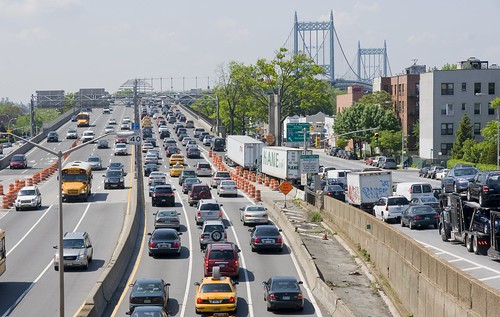
The Robert F. Kennedy (RFK) Bridge, better known as the Triborough or Triboro Bridge, is a complex of three separate bridges in New York City, United States. Spanning the Harlem River, the Bronx Kill, and the Hell Gate (part of the East River), the bridges connect the boroughs of Manhattan, Queens, and The Bronx via Randall's Island and Ward's Island, which are joined by landfill.
Often historically referred to as simply the Triboro, the spans were officially named after Robert F. Kennedy in 2008.
History
Plans for connecting Manhattan, Queens and the Bronx were first announced by Edward A. Byrne, chief engineer of the New York City Department of Plant and Structures, in 1916. While its construction had been long recommended by local officials, the Triborough Bridge did not receive any funding until 1925, when the city appropriated funds for surveys, test borings and structural plans.

Construction had begun on Black Friday in 1929, and the Triborough project's outlook began to look bleak. Othmar Ammann's assistance was enlisted to help simplify the structure. Ammann had collapsed the original two-deck roadway into one, requiring lighter towers, and thus, lighter piers. These cost-saving revisions saved $10 million on the towers alone. Using New Deal money, the project was resurrected in the early 1930s by Robert Moses and the bridge was opened to traffic on July 11, 1936.
The total cost of the bridge was more than $60 million, greater than that of the Hoover Dam, and was one of the largest public works projects of the Great Depression. The structure used concrete from factories from Maine to Mississippi. To make the formwork for pouring the concrete, a whole forest on the Pacific Coast was cut down.
The bridge is owned by the City of New York[citation needed] and operated by the Triborough Bridge and Tunnel Authority (TBTA), an affiliate agency of the Metropolitan Transportation Authority (New York).
The American Society of Civil Engineers designated the Triborough Bridge Project as a National Historic Civil Engineering Landmark in 1986. Motorists were first able to pay with E-ZPass in lanes for automatic coin machines at the Randall's Island toll plazas on August 21, 1996.

At some point in the past, a sign on the bridge informed travelers, "In event of attack, drive off bridge", New York Times columnist William Safire wrote in 2008. The "somewhat macabre sign", he wrote, must have "drawn a wry smile from millions of motorists.
On November 19, 2008, and pursuant to a request made by the Kennedy family, the Triborough Bridge was officially renamed after Robert F. Kennedy, who served New York as a senator, 40 years after his assassination. Since then, the term RFK-Triborough has become increasingly popular as a nickname for the bridge, with typical traffic reports using the name.[citation needed]
On May 5, 2010, the NYPD closed the bridge and sent in the bomb squad to investigate a U-haul truck which a man had reportedly fled from. This investigation came just days after a failed attempt at a car bombing in Times Square. A short time later, the NYPD deemed this incident nonthreatening and reopened the bridge shortly afterward.

Official name robert F. Kennedy Bridge
Other name(s) Triborough Bridge, Triboro Bridge
Carries 8 lanes of I-278
Crosses East River, Harlem River and Bronx Kill
Locale New York City, United States
Maintained by Triborough Bridge and Tunnel Authority (TBTA)
Design Suspension bridge, lift bridge, and truss bridge
Total length 847.34 meters (2,780 feet) (Suspension span)
234.70 meters (770 feet) (Lift span)
487.68 meters (1,600 feet) (Truss span)
Width 29.87 meters (98 feet) (Suspension span)
Longest span 420.62 meters (1,380 feet) (Suspension span)
94.49 meters (310 feet) (Lift span)
116.74 meters (383 feet) (Truss span)
Vertical clearance 14 feet 6 inches (4.4 m), but trucks onbound from Manhattan are limited to 13 feet 10 inches (4.2 m)
Clearance below 43.57 meters (143 feet) (Suspension span)
41.15 meters (135 feet) (when raised) (Lift span)
16.76 meters (55 feet) (Truss span)
AADT 165,670 (Suspension span, 2006)
88,121 (Lift span, 2008)
78,399 (Truss span, 2008)
Opened July 11, 1936
Toll $5.50 as of July 12, 2009 (between any 2 boroughs per car in cash) ; discount available with New York State E-ZPass

Usage-
The toll revenues from the Robert F. Kennedy Bridge pay for a portion of the public transit subsidy for the New York City Transit Authority and the commuter railroads. The bridge carries approximately 200,000 vehicles per day.
The bridge has sidewalks in all three legs where the TBTA officially requires bicyclists to walk their bicycles across due to safety concerns. However, the signs stating this requirement have been usually ignored by bicyclists, while the New York City Government has recommended that the TBTA should reassess this kind of bicycling ban. Stairs on the 2 km (1.3 mile) Queens leg impede handicapped access. The Queens stairway along the southern side was demolished at the beginning of the 21st century, thus isolating that walkway, but the ramp of the Wards Island end of the walkway along the northern side was improved in 2007. The two sidewalks of the Bronx span are connected to only one ramp at the Randalls Island end.

The Triborough Bridge and Tunnel Authority's most recent toll increase went into effect on July 12, 2009. The cash charge for passenger vehicles to cross the bridge was raised to $5.50 (from $5.00) in any direction. The toll for E-ZPass users raised to $4.57 (from $4.15). The crossing charge for a motorcycle increased to $2.50 (from $2.25), with motorcycle tolls with E-ZPass rising to $1.99 (from $1.81). The return trip from Randall's Island to any borough is free.






